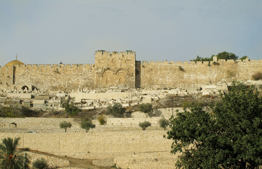Parashat Tetzave: Contradictory Mitzvot and Accepting the Yolk of Heaven

About forbidden mixtures, the mitzvah of wearing sha'atnez in the priestly garments, and how this impacts our service of G-d. Another forbidden mixture: what is the ratio you need when your orlah apple gets mixed into permitted apples? And a visit to Ein Bidan with its famous pomegranates.
Judaism generally frowns upon drinking wine to intoxication; one could say that this is viewed even as repulsive. This is why we might be confused on Purim, when we are commanded to get drunk: how is it that something that is considered so reprehensible all year long becomes a mitzvah?
Many answers and explanations were given, relating to many levels of intoxication and sobriety … but the question, which appears in many forms throughout the Torah, remains in place. One of the places where this question arises in a drastic form is in our parasha, with regard to the priestly garments.
Forbidden and permissible sha'atnez
We are intimately familiar with the prohibition against kila'im, forbidden mixtures. There are many categories of forbidden mixtures: in the plant world: kilei hakerem (interplanting with vineyards), kilei zera'im (interplanting seeds), and kilei ilanot (forbidden grafting). There are also forbidden mixtures in the animal world: it is forbidden to cross-breed different species of animals, kilei beheima. Another forbidden mixture is to mix a product from the animal kingdom with a product of the plant kingdom: kilei begadim, forbidden mixtures with garments: wearing a garment woven from woolen thread (a sheep product) and linen thread (a flax product) is forbidden, and is also called sha'atnez.
Yet here, our parasha opens with a description of the ephod of the Kohen Gadol. The Torah tells us that it is woven from threads of zahav, techelet, argaman, tola'at shani, and shesh moshzar. Zahav is gold, which is metallic, but what about the rest of the list? The Rambam explains in Hilchot Klei HaMikdash (8:13): "Every time the Torah mentions shesh or bad, this is linen and also called butz. Anywhere it mentions techelet, this is the wool dyed the color of the sky, lighter than blue. Argaman is wool dyed red. And tola'at shani is wool dyed [crimson] with a worm."
In other words, the ephod was composed of wool (techelet, argaman, tola'at shani) and linen (shesh), 100% sha'atnez! Not only the ephod, but also the ephod's embroidered band, the choshen, and even the avnet (belt) of the Kohen hedyot. And the resounding question is: how is it that the Torah prohibits us from wearing sha'atnez, but obligates the Kohanim to do so—to the point that if one of their priestly garments is missing when bringing a sacrifice, the sacrifice will be null and void, and the Kohen himself is punishable by death in the hands of Heaven (ibid. 10:4)?!
"Since the sons of Israel are my servants"
We know that each mitzvah has a reason behind it—at times we understand it, at times we don't, and sometimes we only understand it in part; however, the foundation of our observance is accepting the yolk of Heaven. We observe G-d's commandments since we are His servants. He commands—and we observe.
It is far easier for us to become accustomed to doing something that was once forbidden and now become permitted—as long as it is always stays that way, so it makes sense to us. But this is not the point. The goal is to become internalize that we are G-d's servants. It could be that at one point He commands us to do one thing, and then later to do the exact opposite. Whoever decides to be "machmir" and wear sha'atnez-free priestly garments will be defying G-d's will!
As G-d's servants we have to be constantly prepared to do His will, not only in within our comfort zones and provided that we understand what He wants of us, but also when His will flies in the face of our limited logic—and is even the opposite of what the Torah itself commanded us. This in and of itself is considered an integral part of the service of G-d: accepting the yolk of Heaven.
Orlah mixtures
The laws of mixtures between forbidden and permitted substances are relatively intricate and complex, but anyone who sets foot in the kitchen needs to be familiar with them: if someone accidentally mixed their hot chocolate with a fleishig spoon, or cut up an onion with a milchig knife that they wanted to throw into the chicken soup. However, the laws of these mixtures, dinei ta'arovet, include additional areas: orlah, for instance. Fruit from trees in their first three years of being planted are prohibited for consumption and benefit (it is also forbidden to sell them to a non-Jew or feed them to an animal). What happens when there is a mixture of orlah and permissible fruit? At a certain ratio of permissible to prohibited fruit, the prohibited fruits are nullified, but this ratio is larger by far than most mixtures between permitted and prohibited substances: not a majority, not 1:60, and not even 1:100 (as is the case when teruma gets mixed into regular fruit). The necessary ratio for orlah is 1:200!
Important fruits that do not become nullified
Even this stringent leniency of 1:200 does not apply to all fruits. There are certain special fruits that are never nullified, no matter the ratio (Mishna Orlah 3:6). One such fruit is "the pomegranates of Bedan." These pomegranates were extraordinary in their size and popularity. For this reason, each fruit was considered sufficiently important so that if one was orlah and mixed into a huge quantity of other pomegranates, they would never be nullified.
These pomegranates are mentioned in two additional contexts in the Mishna. In tractate Keilim (17:5), Rabbi Yochanan ben Nori says that a vessel with a perforation the size of a Bedan pomegranate is no longer worthy of being used as a vessel, so it can no longer contract impurity. Rabbi Yossi holds that Bedan pomegranates, grown by Kutim (Samaritans), should be considered as definitely untithed (mitasrin vaday), since only Kutim—not Jews—cultivate such pomegranates.
Ein Bidan
The name Bedan mentioned several times in Mishnaic and Talmudic literature was preserved in the name of famous spring in Samaria, Ein Bidan, found at the foot of Mt. Kabir and modern day Elon Moreh. Abraham Frankel believes that there is a tradition hinted at in an ancient liturgical text that this is the site where Avraham Avinu set up the first altar when he entered the Land of Israel. It is possible that the source of the name is the great-grandson of Machir, son of Menashe (Divrei HaYamim 1:7:17), as this area is part of his tribal portion.
This region was settled by the Samaritans, whose relationship with the Jews was extremely complex. They claim that they are the original Jews, while according to the book of Melachim, these were peoples who were relocated to settle the Israelite kingdom after it was destroyed by Ashur (ASSYRIAN). They converted due to their fear of the lions that devoured them when they worshiped idols. It is possible that these converts also intermarried with remnents of the historical residents of the Israelite kingdom.
Ein Bidan is a large spring whose waters flow into Nachal Tirzah, and are used to serve the residents of Shechem (Nablus). Alongside the stream is an important road mentioned in the Tanach, derech mavo hashemesh, through which Yaakov Avinu entered the Land of Israel. Unfortunately, untreated sewage waters from the Arab locals also flow into the stream. However, the banks of the stream are full of orchards irrigated by the waters of the stream, springs, and wells nearby.




